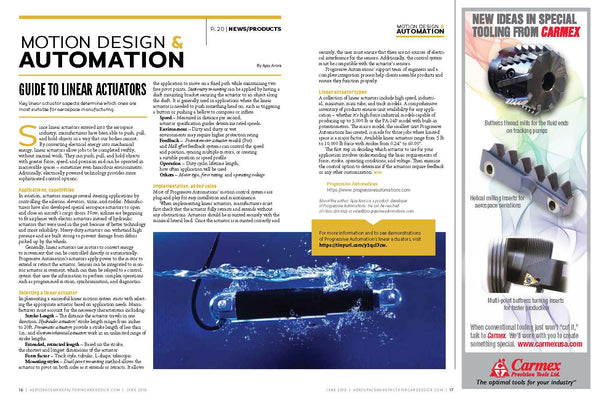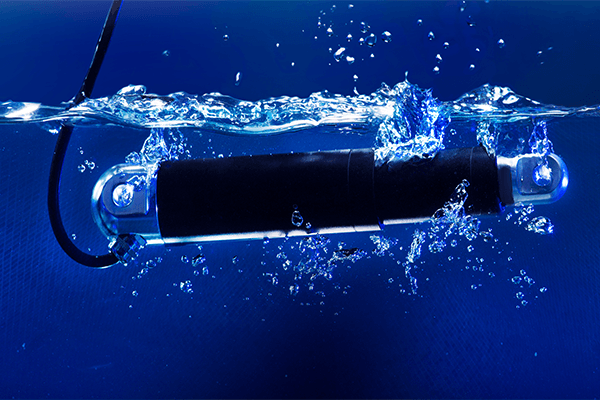Progressive Automations was featured in the Aerospace Manufacturing & Design Magazine. This article was authored by Ajay Arora, Director of Research and Development at Progressive Automations

Since linear actuators entered into the aerospace industry, manufacturers have been able to push, pull, and hold objects in a way that our bodies cannot. By converting electrical energy into mechanical energy, linear actuators allow jobs to be completed swiftly, without manual work. They can push, pull, and hold objects with greater force, speed, and precision and can be operated in inaccessible spaces – sometimes even hazardous environments. Additionally, electrically powered technology provides more sophisticated control options.
Applications and capabilities
In aviation, actuators manage several steering applications by controlling the ailerons, elevators, trims, and rudder. Manufacturers have also developed special aerospace actuators to open and close an aircraft’s cargo doors. Now, airlines are beginning to fit airplanes with electric actuators instead of hydraulic actuators that were used in the past because of better technology and more reliability. Heavy-duty actuators can withstand high pressure and are built strong to prevent damage from debris picked up by the wheels.
Generally, linear actuators use motors to convert energy to a movement that can be controlled directly or automatically. Progressive Automation’s actuators apply power to the motor to extend or retract the actuator. Sensors can be integrated to monitor actuator movement, which can then be relayed to a control system that uses the information to perform complex operations such as programmed motion, synchronization, and diagnostics.
Selecting a linear actuator
Implementing a successful linear motion system starts with selecting the appropriate actuator based on application needs. Manufacturers must account for the necessary characteristics including:
Stroke Length – The distance the actuator travels in one direction. Hydraulic actuators’ stroke length ranges from inches to 20ft. Pneumatic actuators provide a stroke length of less than 1m, and electromechanical actuators work in an unlimited range of stroke lengths.
Extended, retracted length – Based on the stroke, the shortest and longest dimensions of the actuator
Form factor – Track style, tubular, L-shape, telescopic.
Mounting styles – The dual-pivot mounting method allows the actuator to pivot on both sides as it extends or retracts. It allows the application to move on a fixed path while maintaining two free pivot points. Stationary mounting can be applied by having a shaft mounting bracket securing the actuator to an object along the shaft. It is generally used in applications where the linear actuator is needed to push something head-on, such as triggering a button or pushing a bellow to compress or inflate.
Speed – Measured in distance per second, actuator specification guides determine rated speeds.
Environment – Dirty and dusty or wet environments may require a higher protection rating.
Feedback – Potentiometer actuator models (Pot) and Hall effect feedback systems can control the speed and position, syncing multiple motors, or creating a suitable position or speed profile.
Operation – Duty cycle, lifetime length, how often the application will be used.
Others – Motor type, force rating, and operating voltage.
Implementation, added value

Most of Progressive Automations’ motion control systems are plug-and-play for easy installation and maintenance.
When implementing linear actuators, manufacturers must first check that the actuator fully retracts and extends without any obstructions. Actuators should be mounted securely with minimal lateral load. Once the actuator is mounted correctly and securely, the user must ensure that there are no sources of electrical interference for the sensors. Additionally, the control system must be compatible with the actuator’s sensors.
Progressive Automations’ support team of engineers and a complete integration process help clients assemble products and ensure they function properly.
Linear actuator types
A collection of linear actuators include high speed, industrial, miniature, mini tube, and track models. A comprehensive inventory of products ensures unit availability for any application – whether it’s high-force industrial models capable of producing up to 3,000 lb or the PA-14P model with built-in potentiometers. The micro model, the smallest unit Progressive Automations has created, is made for those jobs where limited space is a major factor. Available linear actuators range from 5 lb to 10,000 lb force with strokes from 0.24" to 60.00".
The first step in deciding which actuator to use for your application involves understanding the basic requirements of force, stroke, operating conditions, and voltage. Then examine the control option to determine if the actuators require feedback or any other customization.
To read Aerospace Manufacturing & design click here.




